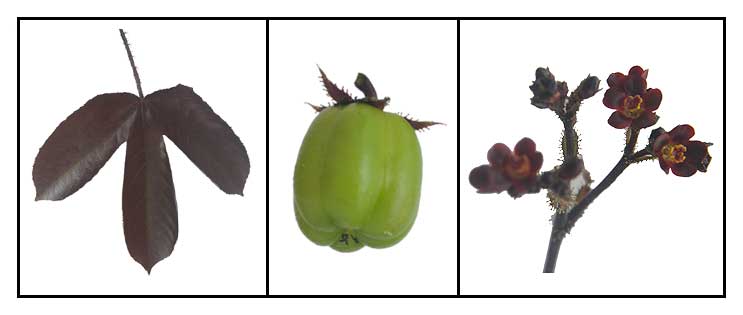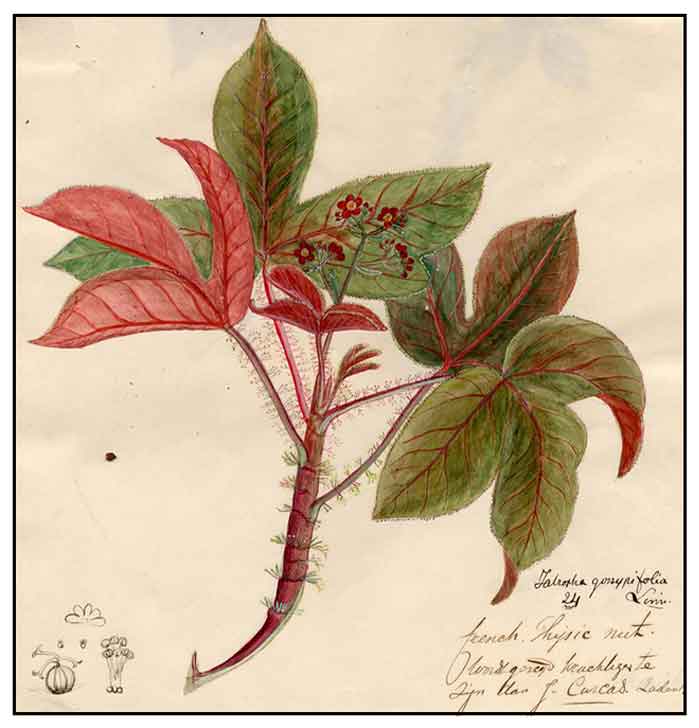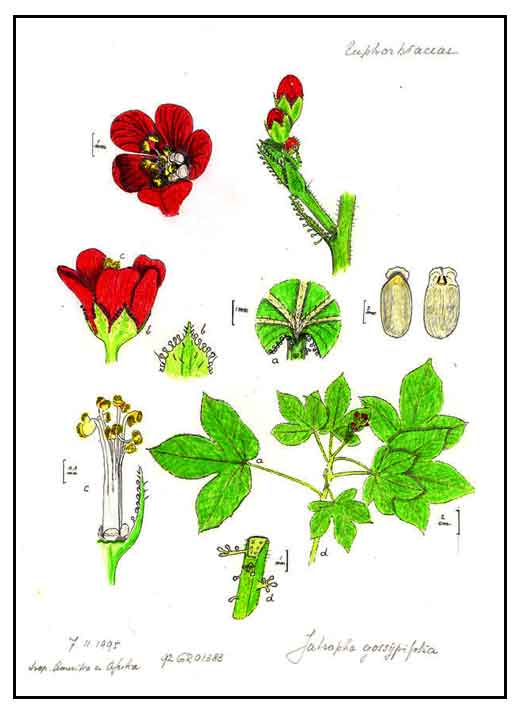
Etymology
Jatropha derives from the Greek words "jatros" meaning doctor, and "trophe" meaning food.
Botany
Tuba-tuba is an erect, branched shrub usually less than one meter high. Petioles, leaf margins and inflorescences are covered with numerous, capitate-glandular hairs. Leaves are shining, smooth, palmately 3- or 5-lobed, 7 to 12 centimeters long, the lobes oblong-ovate and the younger leaves being purplish. Flowers are purple, small, borne on cymes. Capsules are usually 3-lobed, about 1 centimeter long.
 Distribution Distribution
- In waste places at low altitudes in Amburayan; in Ilocos Sur, La Union, Pangasinan, Rizal Provinces in Luzon; and in Biliran, Leyte, Negros, Cebu, and Mindanao.
- Native of tropical America.
- Now pantropic.
Constituents
- Roots yield a very toxic alkaloid, jatrophine, 4 %.
- Stem yields an active principles, a glucoside and a resin.
- Reported to contain psychoactive substances: protease curcain, the alkaloid jatrophine, the cyclic heptapeptide, cyclogossine A, saponins and numerous fatty acids.
- Latex yielded a new cyclic octapeptide, cyclogossine B, together with the known cyclic heptapeptide, cyclogossine A.
- Study of ethanol extract of leaves yielded the presence of phenols flavones, glycosides, steroids, alkaloids, and quinines. Quantification yielded 3.35 mg/kg of alkaloids, 3.60 mg/kg flavonoids, 0.22 mg/kg tannins, and 0.12 mg/kg glycosides. Elemental analysis yielded high level of calcium (3.89%) and iron (85 ppm). HPTLC confirmed the presence of alkaloids, quercetin and fraxetin. GC-MS analysis yielded p-cymene, fumaric acid, 12-octadecanoic acid, 1-heptadecanol and yashabushiketol. (see study below) (15)
- Study of leaves for major inorganic constituents yielded 2.09% moisture, 2.49% organic carbon, 1.21% nitrogen, 3.02% potassium, 0.05% sodium, 3.89% calcium, 3.06% magnesium, 2.09 ppm zinc, 0.40 ppm copper, 85.19 ppm iron, 50-56 ppm manganese, and 0.02 ppm molybdenum. (see study below) (15)
- Methanol and ethanol extracts yielded alkaloids, phenols, steroids and glycosides.
- Various extracts of leaves yielded saponin, tannin, flavonoid, organic acid, glycosides, diterpene, alkaloids, steroids, xanthoprotein, and starch.
- Study of leaf essential oil for volatile components yielded main constituents of sesquiterpenoid germacrene D-4-ol (23.3%), hexahydrofarnesylacetone (15.4%), δ-cadinene (7.7%), tetradecanal (6.8%) and cubenol (6.1%). (23)
- Proximate analysis of J. gossypiifolia leaf yielded crude fat 6.36%, crude protein 14.80%, carbohydrate 34.18%, ash 9.38%, crude fiber 10.31%, moisture content 24.97%, caloric value 253.16 kcal/100g. (24)
- GC-MS analysis of leaf ethanol extracts yielded 18 compounds
with lanosterol (32.47%) and (-)-globulol (18.96%) peak areas. (32)
- GC-MS analysis of methanolic extract of leaves yielded 34 phytoconstituents. Major constituents identified were 1-Monolinoleoylglycerol trimethylsilyl ether (9.58%); 2, 4-heptadienal (E,E) (6.77%); carotene, 1,1’,2,2’-tetrahydro- 1,1’-dimethoxy (4.92%); ergosta-5,22-dien-3-ol, acetate (4.59%); lanosterol (31.8%) and stigmasterol (2.07%). Cardenolide and bufadienolide derivatives and various fatty acid derivatives like docosanoic acid, 1,2,3-propanetriyl ester; 9,12,15-octadecatrienoic acid, triolein etc. also reported in GC-MS analysis. (36)
Properties
- Studies suggest hemostatic, wound healing, analgesic, anti-inflammatory, antimicrobial, antidiabetic, hepatoprotective, insecticidal, antidiarrheal, antioxidant, anticancer, anti-plasmodial, anti-acetylcholinesterase properties.
Parts used
Leaves, roots, latex, bark, seeds.
 Uses Uses
Edibility
- In Nigeria, young leaves used in making soup. (see nutrient analysis above) (24)
Folkloric
- In the Philippines, cataplasm of fresh leaves is applied to swollen breasts.
- In Venezuela, roots are used in leprosy; decoction of leaves used as purgative and stomachic.
- Latex used on ulcers.
- Latex topically used for treatment of wounds and venomous
animal bites. Seeds and fruits used for treatment of influenza; also used as sedative, analgesic, and anti-diarrheal. (48)
- In Antilles, leaves are used as febrifuge for intermittent fevers.
- Decoction of bark used as emmenagogue.
- Leaves applied to boils and carbuncles, eczema and itches.
- In the Gold Coast, leaves and seeds used as purgative.
- Leaves are boiled and used as baths for fevers.
- Juice used for sores on babies' tongues.
- In the Gold Coast, the pith of old, thick stems yield a yellowish, brown substance which is placed in a clean cloth and squeezed into the nostrils, causing the patient to sneeze and cure the headache.
- Decoction of leaves used for venereal disease and as blood purifier.
- Seeds contain an oil which is purgative and emetic.
- Used to treat snake bites.
- Oil from the seeds used for leprosy.
- The Madoerese used the roasted seeds as purgative.
- In Bangladesh, bark decoction used as emmenagogue. Leaves used as purgative; applied to boils, eczema and itches. Sap from leaf petioles mixed with molasses to treat dysentery. Seed oil used for skin diseases, but reported to cause insanity. Regular brushing of the teeth with twigs help prevent teeth and gum disease. (19)
- In Nigeria, used in the treatment of ringworm, malaria, tumors, typhoid fever, tuberculosis, and dysmenorrhea. (24)
- In Trinidad, leaf decoction is used for bathing wounds; poultices used for sores and pain. Stem sap used to stop bleeding and itching of cuts and scratches. Leaf bath used for sore, sprains, rash, and bewitchment in Latin America and the Caribbean. (42)
Others
- Illuminant: Seeds contain 36% oil; used as an illuminant in Africa.
- Fire barrier / Magical powers: In Africa, swaths are planted around villages as fire barriers. Also believed to protect against lightning, snakes and violence.
Toxicity
• Toxins:Red physic nut contains toxins in the seeds, sap and other tissues which could be fatal to humans. Although, poisoning cases are rare, the use of seeds in herbal medicine should be avoided.
Studies
• Hemostatic / Procoagulant: A study investigating the coagulant activity of J gossypifolia stem latex as a hemostatic agent showed it to have procoagulant activity through precipitation of coagulant factors. (2)
• Hemostatic / Safety Studies: The efficacy of stem latex in stopping bleeding from the nose, gums, and skin has been established. Study on the safety of the stem latex on Wistar albino rats showed no adverse effects on liver, kidney and bone marrow functions. (8)
• Anti-Inflammatory / Analgesic: Study of the methanolic and petroleum ether extracts of Jatropha gossypifolia showed greater anti-inflammatory and analgesic activities compared to standard drugs, indomethacin and diclofenac. The methanolic extract showed more activity than the PE extract in the treatment of pain and inflammation. (3)
• Hepatoprotective: Study showed J gossypifolia with strong hepatoprotective action against carbon tetrachloride induced hepatic damage in rats. Petroleum ether extracts showed maximum protectivity. (4)
• Antibacterial / Leaves: Study on ten human pathogens showed methanol and ethanol extracts of leaves of Jatropha gossypifolia to have antimicrobial activity against S. typhi, S. aureus and P. aeruginosa. Phytochemical screening revealed phlobatannins and tannins in the methanol extract of JG. (5) Solvent extracts of leaves exhibited considerable antibacterial activity against Bacillus subtilis and Escherichia coli. (21)
• Insecticidal / Leaves: Extract from senescent leaves of J. gossypifolia had significant toxicity against Spodoptera litura. (8) Leaf extract showed insecticidal activity against second instar of Spodoptera exigua. (9)
• Analgesic / Neuropharmacologic / Anti-Diarrheal / Fruits / Leaves: In vitro study evaluated a methanol extract of fruits. Results showed highly significant analgesic activity by acetic acid induced writhing inhibition test. It showed significant sedative effect and highly significant anxiolytic activity. It also showed highly significant anti-diarrheal activity. (12) Study of methanolic extract of leaves of J. gossypiifolia showed highly significant (p<0.001) analgesic activity with inhibitions of writhing response, significant (p<0.05) sedative effect in the hole cross test, and highly significant (p<0.001) anxiolytic activity in the hold board test, and highly significant (p<0.001 anti-diarrheal activity in castor oil induced diarrhea. (25)
• Antimicrobial / Anti-Inflammatory / Bark: Study evaluated J. gossypifolia bark extracts for antimicrobial and anti-inflammatory potential. The methanol extract showed prominent antimicrobial activity. Both methanol and petroleum ether extracts significantly reduced carrageenan-induced paw edema in rats. (13)
• Antioxidant / Phytochemical Content: Study evaluated the phytochemical composition and in vitro antioxidant potential of J. gossypiifolia. Ethyl acetate extract of J. gossypiifolia showed high vitro antioxidant activity by DPPH radical scavenging assay. Presence of high levels of potassium, calcium, magnesium, iron and manganese on elemental analysis of leaves suggests a potential natural source of essential micronutrients. (see constituents above) (15)
• Anti-Inflammatory / Membrane Stabilization Method / Leaves: Study evaluated the anti-inflammatory activity of aqueous and alcoholic extract of leaves by in vitro HRBC membrane stabilization method. The aqueous extract at 200 µg/ml showed significant activity when compared with standard drug Diclofenac. (16)
• Anticoagulant / Antioxidant
/ Leaves: Study evaluated the anticoagulant and antioxidant activities of J. gossypiifolia leaves. A crude leaf extract showed significant anticoagulant activity in aPTT test, with no activity noted in PT test, suggesting preferential activity toward the intrinsic and/or common pathway of coagulation. No effect was seen in the fibrinolytic system. The residual aqueous fraction showed significant antioxidant activity in all models tested. Results suggest a potential new source of bioactive molecules. (17)
• Antioxidant / Cytotoxicity on HeLa Cell Line: Study for antioxidant potential showed an IC50 of >250 mg/mg by nitric oxide scavenging assay and 25.33 mg/ml by reducing power assay. It showed significant in vitro cytotoxity activity on HeLa cell lines. (18)
• Anticarcinogenic Against Cypermethrin-Induced Genotoxicity / Leaves: Study evaluated the protective effect of methanolic extract of Jatropha gossypiifolia leaves against Cyp-induced genotoxicity in rats using alpha-lipoic acid (α-LA) as standard drug. The ME of leaves showed potential to ameliorate Cyp-induced genotoxicity in mice. Toxicological testing showed the extract to be safe at the investigative doses. (22)
• Nutrient Potential of Leaves: Study of leaves of J. gossypiifolia showed a substantial amount of nutrients: proteins, carbohydrates, fibers, vitamins (C, E, and K), and minerals. Secondary metabolites such as alkaloids, carotenoids, phenolics, flavonoids, tannins and sterols were present in appreciable amounts. Study suggests consumption of J. gossypiifolia in sufficient amount can contribute greatly to human nutritional requirement. (24)
• Wound Healing / Roots: Study evaluated the wound healing potential of various ointment preparations from root extracts of J. gossypifolia. Results showed significant (p<0.01) increase in breaking strength of incision wounds. In diabetic rats, the methanol and aqueous extracts exhibited extraordinary wound healing capacity and elevated hydroxyproline content. Increased hydroxyproline content signify increased collagen deposition in wounded tissues as evidenced from histopathology. (26)
• Local Anesthetic Activity: Study evaluated the local anesthetic activity of aqueous and methanolic extracts of J. gossypiifolia by plexus anesthesia in frogs. Results showed significant local anesthetic activity which could be attributable to the presence of alkaloids, tannins, and resins. (27)
• Antidiabetic / Roots: Study evaluated the antidiabetic activity of successive extracts of roots of Jatropha gossypiifolia in an alloxan induced diabetic mice model. A methanol extract showed significant reduction in plasma glucose, followed by the aqueous extract. (28)
• Purgative / Antipyretic / Leaves: Study of ethanolic and acetone extract of leaves showed significant antipyretic and purgative activities. Phytochemical screening yielded primary metabolites such as sugars, amino acids, proteins and chlorophyll and secondary metabolites like alkaloids, flavonoids, and tannins. (29)
• Piscicidal / Anti-AChE Activity / Apigenin / Latex: Study of latex powder and apigenin from Jatropha gossypiifolia plant showed strong piscicidal and dose-dependent anticholinesterase (anti-AChE) activity on fish Channa punctatus. The inhibition of the enzyme may be through activation of protein kinase C. (30)
• Jatrophone / Cytotoxic Diterpenes
/ Stem Bark: Study of two Jatropha plants: J. gossypiifolia and J. curcas yielded three diterpenes: jatrophone from the stem bark of J. gossypiifolia and curcusone B and jatropholone A from stem barks of J. curcas. Jatrophone from J. gossypiifolia showed better anticancer potency than curcusone B and jatropholone A from J. curcas against HeLa and WiDr lines, and better than anticancer standards, Tamoxifen and Doxorubicine. (31)
• Antihyperglycemic / Antihyperlipidemic: Study of J. gossypiifolia methanol extract in STZ-nicotinamide induced diabetic model showed antihyperglycemic and antihyperlipidemic activities as evidenced by a significant increase in HDL and decrease in creatinine, triglycerides, total cholesterol and VLDL, along with a significant decrease in liver function parameters such as SGOT and SGPT and significantly increased liver glycogen content. (33)
• Antiophidic / Snake Venom Inhibition / Leaves: Study evaluated the antiophidic properties of Jatropha gossypiifolia. An aqueous leaf extract was able to inhibit enzymatic and biologic activities induced by Bothrops jararaca snake venom in vitro and in vivo. The inhibition of myotoxic action of B. jararaca was almost 100%. The antiophidic activity may be due to an inhibitory action upon snake venom metallo-proteinases (SVMPs) and/or serine proteinases (SVSPs), including fibrinogenolytic enzymes, clotting factors activators, and thrombin-like enzymes. (34)
• Antiemetic and Gut Modulatory Activities / Validation of Folkloric Use: An ethanolic extract of Jatropha gossypifolia showed significant antiemetic potential (p<0.05) against different emetogenic stimuli, when compared to chlorpromazine. The extract exhibited spasmogenic effect when applied to isolated rabbit jejunum. Atropine blocked the spasmogenic effect while spasmolytic effect was observed, suggesting involvement of muscarinic receptor activation. H. gossypifolia caused relaxation of high K+ induced contraction and shifted Ca++ concentration response curve to the right similar to verapamil, thus confirming Ca++ channel inhibitory activity. Results provide pharmacological validation of antiemetic and gut modulatory (spasmogenic and spasmolytic) activities validating its folkloric use. (35)
• Acute Toxic Effects on Fish and Mice: Study evaluated the possible toxic effects and mortality caused by crude latex and compound apigenin from leaves of J. gossypifolia on freshwater snakehead fish, Channa punctatus and Swiss albino mice Mus musculus. Against C. punctatus, toxicity was both time- and dose-dependent, while in mice, toxicity was only study dose-dependent with much higher LC doses. (37)
• Antibacterial Against Human Pathogens / Leaves: Study evaluated the antibacterial activity of aqueous and ethanol extract of various plant parts of J. gossypifolia using disc diffusion method. The extracts were active against both gram-positive and gram-negative bacteria. Leaf extract were more effective against S. aureus. (38)
• No Visceral Histopathological Alterations / Air-Dried Leaves: Study evaluated the histopathological alterations in male Wistar rats treated with ethanol extract of air dried leaves of J. gossypifolia, given daily for 30 days at doses of 62.5, 1225, and 250 mg/kg doses. Results suggested J. gossypifolia probably has no deleterious effect on the visceral organs (kidneys, livers, and hearts) in male rats. (39)
• Jatrophone / Anticancer Activity /
Hepatocellular Cancer Cell HepG2 / Stem Bark: Jatrophone isolated from the stem bark of J. gossypifolia. Study evaluated the cytotoxic effect of Jatrophone against against human liver cancer cell line He[G2 1886 using MTT assays. Results showed cytotoxic potency against liver cancer cell line GepG2 1886 with IC50 of 3.2 µM. Jatrophone also showed IZZC50 values of 8.97, 5.13, and 2.5 µM against human colon cancer line WiDr, cervix cancer cell line HeLa and stomach cancer AGS, respectively. Jatrophone showed better anticancer activity against liver cancer cell line HepG2 than standard anticancer drugs such as sorafenib and ATO (Arsenic Trioxide). (40)
• Hypoglycemic / Flavonoids: A chromatographic fraction administered intraperitoneally in mice reduced glucose by 42% in a mouse model of T2DM. A flavanone was purified from the active fraction. Study a flavanone purified from an active fraction, with previously reported activity of stimulating in vitro glucose uptake in a concentration dependent manner. Study indicated extracts of J. gossypifolia enhance glucose uptake in cultured myotubes and adipocytes and also improve glucose tolerance in an in vivo model. (41)
• Exacerbation of Potassium Bromate-Induced Clastogenicity, Hepatotoxicity and Lipid Peroxidation / Leaves: Study investigated the anti-clastogenic and hepatoprotective effects of ethanolic leaf extract of J. gossypifolia in potassium bromate-induced toxicity in rats. Results showed the ethanolic leaf extract may not have a protective role against chromosomal and liver damage in KBrO3-induced toxicity, and, in fact, may have complicating effects. (43)
• Genotoxic Potential of Latex: Study evaluated the toxic, cytotoxic, and genotoxic effects of the latex of J. gossypifolia using Allium cepa as test system. The latex showed significant decrease in root mean growth value as well as mitotic index. Concentrations of 1.25, 2.5 and 5 mL/L induced significant chromosome adherences, C-metaphases and/or chromosome bridges, as genotoxic effects. Results caution that its used for medicinal purposes may be harmful to humans especially if ingested. (44)
• No Effect on Erythrocyte Osmotic Fragility: Study investigated the effect of an ethanolic extract of plant on erythrocyte osmotic fragility in male Wistar rats. Results showed the ethanol extract probably has no significant effect on erythrocyte osmotic fragility in male rats, vis-a-vis. it is probably ineffective in the treatment of hemolysis. (45)
• Antiplasmodial / Leaves: Study evaluated the in vivo antiplasmodial effect of ethanol extract pf J. gossypiifolia leaves and fractions in Plasmodium berghei infected mice. Phytochemical screening of leaves yielded saponins, tannins, phlobatannins, alkaloids, flavonoids, terpenoids, and cardiac glycosides. The fractions exhibited moderate to good prophylactic and curative activities, with the ethyl acetate showing the best activity in both test models. Results suggest the leaf extract and fractions are safe and possess antiplasmodial activity, which confirm its folkloric medicinal use. (46)
• Anticancer Diterpenoid / Root Bark: Study evaluated the anticancer activity of root extract of J. gossypifolia. Phytochemical analysis isolated a new diterpenoid along with four well-known compounds. The new compound showed proliferation inhibitory activity against A-549 human cancer cell line. (47)
• Platinum Nanoparticles / Antibacterial / Leaves: Study reports on the green synthesis of platinum nanoparticles using Jatropha gossypifolia and J. gaundulifera leaf extracts. The platinum nanoparticles showed good activity against Gram-positive and Gram-negative pathogenic bacteria. (49)
• Antihyperlipidemic Effect of Tannins in Nicotinamide Induced Diabetes: Study evaluated the anti-diabetic and anti-hyperlipidemic activity of isolated tannins from methanolic extract of J. gossipyfolia in streptozotocin-nicotinamide induced diabetic male wistar rats. Results showed anti-diabetic and anti-hyperlipidemic effect in tannin treated rats. (50)
Availability
Wild-crafted.
|

![]()





 Uses
Uses 